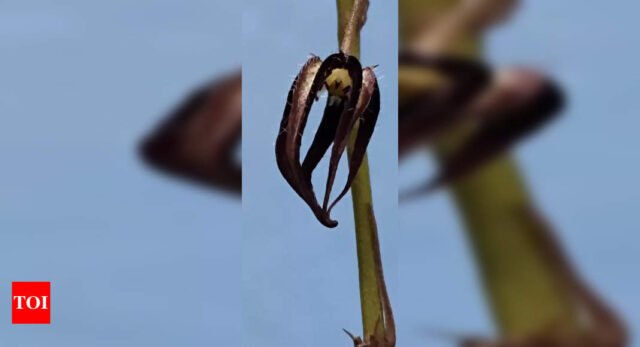Hyderabad: Brachystelma bilobatum, a rare plant from the Asclepiadaceae family, bloomed at the Telangana Botanical Garden housed in Dr BRR Govt Degree & PG College, Jadcherla, Mahabubnagar district. This marks the first recorded bloom of the species outside its native habitat. The plant was first discovered in 2020 in the Nallamala forests by Dr B Sadasivaiah of Dr BRR Govt Degree College and Dr K Prasad of Sri Venkateswara College, New Delhi. Until now, it was documented in only two known localities in that forest region.
Brachystelma bilobatum is a hysteranthous plant, meaning it produces flowers before leaves. It grows up to 25cm tall with a slender stem, bearing a few sessile leaves reaching 7cm. The plant’s round tuber, edible and consumed by both tribal communities and wild animals, is also noted for its traditional medicinal use. Flowering typically occurs from April to June. The flowers emerge in pairs at nodes, are about 1cm long, deep maroon to nearly black, and are covered with white hairs. The staminal corona’s deeply bilobed structure gives the species its name.
Dr G Sukanya, principal of the host institution, emphasised the role of the Telangana Botanical Garden in preserving rare and endemic species. She noted that such blooms offer practical exposure to botany students and researchers. While tubers of other Brachystelma species are traditionally used to treat various ailments, Dr Sadasivaiah underlined that the medicinal potential of the plant remains under-researched and requires further scientific validation.
Brachystelma bilobatum is a hysteranthous plant, meaning it produces flowers before leaves. It grows up to 25cm tall with a slender stem, bearing a few sessile leaves reaching 7cm. The plant’s round tuber, edible and consumed by both tribal communities and wild animals, is also noted for its traditional medicinal use. Flowering typically occurs from April to June. The flowers emerge in pairs at nodes, are about 1cm long, deep maroon to nearly black, and are covered with white hairs. The staminal corona’s deeply bilobed structure gives the species its name.
Dr G Sukanya, principal of the host institution, emphasised the role of the Telangana Botanical Garden in preserving rare and endemic species. She noted that such blooms offer practical exposure to botany students and researchers. While tubers of other Brachystelma species are traditionally used to treat various ailments, Dr Sadasivaiah underlined that the medicinal potential of the plant remains under-researched and requires further scientific validation.






